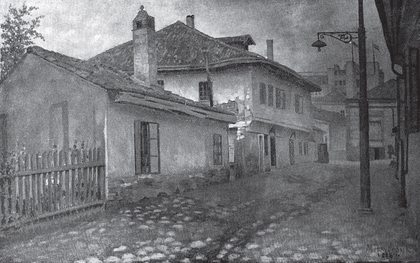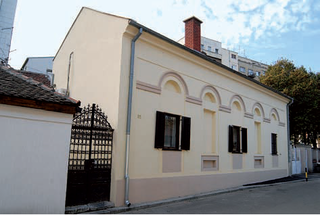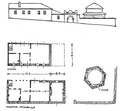Area around the Dositej Lyceum
The cultural-historical spatial unit of the area around the Dositej Lyceum is one of the oldest and most important urban areas in Belgrade , the core of which was formed at the end of the 18th and beginning of the 19th centuries.
location
It covers five blocks of the Stari Grad municipality , between Kralja Petra, Gospodar Jovanova, Kapetan Mišina, Simina, Kneginje Ljubice, Braće Jugovića streets, Studentski trg square and Zmaj od Noćaja streets. In this legally protected unit, the original structural directions and objects of outstanding urban, architectural and cultural-historical value have been preserved to this day. Some of them are linked to the establishment and activity of the most important institutions in Serbia from the time of the First Serbian Uprising : the Praviteljstvujušči sovjet , as the first insurgency government, and the University , as the first higher education institution. The names of outstanding personalities of Serbian history and culture are linked to these objects - the enlightener Dositej Obradović and Vuk Stefanović Karadžić . The original lines of communication, which were taken over in the direction of the street, take their names from particularly important historical figures from the liberation struggle of the Serbian people: Stojan Čupić (“Zmaj od Noćaja”), Filip Višnjić , Ivan Jugović , Jevrem and Jovan Obrenović, Sima Nešić and Miša Anastasijević .
“The area around the Dositej Lyceum” was declared a cultural asset in 1989 and a cultural asset of particular importance in 1990. In addition to these five blocks, two other urban blocks between the streets Zmaj od Noćaja, Cara Uroša, Gospodar Jovanova and Kralja Petra were declared a cultural asset in 1999 and these form the protected area of the cultural and historical spatial unit "Area around the Lyceum of Dositej".
Under part of the central area of Belgrade and also under this urban unit, there is the archaeological site of Roman culture, the civil settlement and the necropolis “ Ancient Singidunum ”, which was created in the period from the 2nd to the 4th century and has been since 1964 is also a cultural asset.
The architectural inventory of these seven blocks is characterized by diversity in terms of style and height, heterogeneity and contrast. Specimens of Islamic, oriental-Balkan architecture and transitional specimens from Balkan to European architecture have been preserved. In addition, specimens of monumental houses in the style of neoclassicism (academicism), romanticism, modernity of the interwar period and objects of modern architecture. The rare earth-and single-storey houses underline the former ambience of the old Belgrade city, while the more numerous academic and modern designed, predominantly four-storey houses indicate the outstanding development of Belgrade between the two world wars. The small number of multi-storey objects in modern architecture were created in the period from the 1970s and 1980s to the beginning of the 21st century and are in stark contrast to the style and height of the earliest single-storey houses. As part of this cultural-historical spatial unit and its protected environment, certain objects have been declared individual cultural monuments due to their great importance. These are mostly grouped along Gospodar Jevremova Street, which has preserved the trace of one of the most important routes from ancient times and the Middle Ages.
Individual monuments
Bajrakli Mosque
The Bajrakli Mosque at 11 Gospodar Jevremova Street was built between 1660 and 1688 as a foundation of Sultan Suleyman II . It is the only surviving object of Turkish sacred architecture in Belgrade. The name dates from the 1780s when bayrak (Turkish for flag) was hoisted on the mosque as a sign of the beginning of prayer in all city mosques. During the Austrian rule from 1717 to 1739 it was converted into a Catholic church and with the return of the Turks it was renovated as a mosque. The interior design is very modest. The openings on the building end with characteristic pointed arches. The mosque was declared a cultural monument in 1946 and a cultural asset of great importance in 1979.
College of Professor Ivan Jugović
In the original building of the university in the courtyard building at Gospodar Jevremova 22, which was built in the second half of the 18th century, the university, the first higher education institution in Serbia, was opened in 1808 with a speech by Dositej Obradović . Its founder and first professor was Ivan Jugović , clerk and secretary of the Praviteljstvujušči sovjet, insurrection diplomat and Minister of Education after Dositej Obradović. The building on the street was built in 1862 and is linked to the history of the conflict between Serbs and Turks .
The Dositej Lyceum building at 21 Gospodar Jevremova Street was built between 1739 and 1789 and is one of the oldest residential buildings in Belgrade. It is at the center of this unit, after which it got its name. The building has retained the characteristics of the oriental-Balkan architecture with bay windows on the upper floor and specific facade processing. It was built with a wooden structure (bondruk), filled with bricks and lime mortar, and covered with roof tiles. At the beginning of the 19th century an adjoining room with a fireplace was added. The house, which is surrounded by a wall, underlines the ambience of this time and the social position of the owner most faithfully. It represents the highest level of building culture of the wealthier class of the Turkish population after the end of the Austro-Turkish wars and before the start of the armed uprising of the Serbian population. Between 1809 and 1813, the work of the college of Professor Ivan Jugović continued in this building . Today it houses the Vuk and Dositej Museum .
House of the Božić family
The house of the Božić family in Gospodar Jevremova 19 from the end of the 18th century represents an important object of oriental-Balkan architecture, which was designed in the reconstruction in 1836. It served as the house of Miloje G. Božić, a trader and Business partner of Prince Miloš Obrenović , who graduated from the university. It has a covered entrance (portico) and a characteristic protruding niche on the opposite side in the back of the house. Since the 1930s, the house was the home and studio of the sculptor Toma Rosandić for a while, and was later called the “artist house”, where several well-known artists lived. The Theater Arts Museum has been located there since 1955. The house was declared a cultural monument in 1946 and a cultural monument of great importance in 1979.
Sheikh Mustafa's Türbe
The Türbe of Sheikh Mustafa in Višnjićeva 1 Street from 1783 and the cellar walls of the outbuilding are the only remnants of the fenced complex of the Islamic Tekke ("monastery" of the Dervish Order) of Haj Sheikh Mohammed from the middle of the 17th century. This ground floor building, which was demolished in 1892, was the seat of the Serbian insurrectionary government, the Praviteljstvujušči sovjet srpski, from 1808 to 1813, and for a short time it was inhabited by the great Serbian scribe and enlightener Dositej Obradović, a member of the sovjet and its first minister of education. The tomb of the Sheikh of Tekke, Mustafa from the Sufi order of dervishes, was initially in the Türbe. Two Tekke chiefs were later buried here. Sheikh Mustafa's Türbe was declared a cultural monument in 1948 and a cultural monument of special importance in 1979.
House of the sculptor Dragomir Arambašić
The house of the sculptor Dragomir Arambašić in the courtyard of Gospodar Jevremova 20 was built in 1906 according to the project of the outstanding architect Branko Tanazević . It was executed in the style of academism, but with elements of secession in the decoration and facade processing. It is located in the immediate vicinity of the previously listed objects of the unit and represents the modern architecture from the beginning of the 20th century. At the core of this unit it shows the continuity of the development of Belgrade architecture and its change from an oriental-Balkan to a European one City. Today the house is used as part of the “Leptirić” kindergarten. It was declared a cultural monument in 1987.
Although the ground floor houses on Gospodar Jevremova 24, Višnjićeva 2, 2а and 2b, Simina 1, 3, 5 and 7 streets were built in different periods, they have a common value through the preservation of the surroundings of old Belgrade and the connection of all the architectural layers of this protected one Unit. Of the objects that once existed in this space, one must not forget: the Kizlar Aga mosque (building of the Turkish police) on the site of the building on Braće Jugovića 12 from the 16th and early 17th centuries; the 19th century house of Uzun-Mirko Apostolović at the point below the Tekke in Višnjićeva Street; the mosque of Hajj Mustafa Čebedžija on the site of Gospodar Jevremova 31 from the 16th century; the house at Kosačina 1 street; Hadži Ridžalov konak on the site of Gospodar Jevremova 15 from the 18th century, on whose place a large ground floor house was built later in the 19th century. It had the function of the city police and the city administration of Belgrade and it housed the notorious Glavnjača prison. The building was on the site of today's Faculty of Mathematics and Natural Sciences. The preserved objects are among the most valuable monuments of Belgrade and Serbia due to their multi-layered significance, architectural-urban quality and age.
Within the framework of these seven blocks of the cultural-historical unit and its protected environment there are also the buildings of the fresco gallery, the Jewish historical museum , the primary school “Mika Petrović Alas” and the hotel “Royal”.
gallery
literature
- А. Gavrilović, Beogradska Velika Škola 1808-1813, Belgrade 1902.
- М. S. Petrović, Beograd pre sto godina, Belgrade 1930.
- L. Arsenijević Batalaka, Velika škola, in: Stari Beograd iz putopisa i memoara, Belgrade 1951.
- Kosta N. Hristić, Velika škola sedamdesetih godina, in: Stari Beograd iz putopisa i memoara, Belgrade 1951.
- D. М. Jovanović, Iz nedavne prošlosti Beograda, Godišnjak muzeja grada III, Belgrade 1956.
- Beograd u XIX veku, Museum of the City of Belgrade, exhibition catalog, book. 5, 1967.
- Beograd u sećanjima, SKZ, Belgrade 1983.
- Ž. Đorđević, Čukur-česma 1862, Belgrade 1983.
- Lj.Cubrić, Muzej Vuka i Dositeja, Belgrade 1994.
- Istorija Beograda, SANU, Balkanološki institut, Special Editions, Book 62, 1995.
- М. Ilić Agapova, Ilustrovana istorija Beograda, Belgrade 2002.
- М. Gordić, Velika škola 1808 - 1813, Belgrade 2004.
- М. Đ. Milićević, Topografske beleške, in: Stari Beograd - putopisi iz XIX veka, Belgrade 2005.
- S. and D. Vicić, Pozdrav iz Beograda 1895 - 1941, Book 1, Belgrade 2008.
- Documentation of the Institute for the Preservation of Cultural Monuments of the City of Belgrade
Individual evidence
- ^ City of Belgrade , Institute for the Protection of Monuments, 2008 catalogs, area around the Dositej Lyceum , author Hajna Tucić
- ^ Institute for Monument Protection, Cultural Assets
- ↑ beogradskonasledje.rs, Dositej Lyceum
- ↑ College of Professor Ivan Jugović . Политика ,. Retrieved November 10, 2013.
- ↑ beogradskonasledje.rs, Bajrakli Mosque
- ^ Historical Archives of Belgrade
- ^ Vuk and Dositej Museum . Archived from the original on June 10, 2017. Info: The archive link was inserted automatically and has not yet been checked. Please check the original and archive link according to the instructions and then remove this notice. Retrieved November 10, 2013.
- ↑ beogradskonasljedje.rs, The House of Miloje Božić
- ^ SANU, Cultural Monuments of Serbia
- ↑ beogradskonasledje.rs, The Türbe of Sheikh Mustafa
- ↑ beogradskonasljedje.rs, The house of the sculptor Dragomir Arambašić












